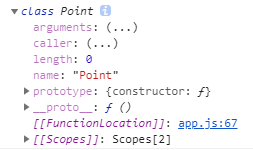es6入门5--class类的基本用法

在ES6之前,准确来说JavaScript语言并无类的概念,却有模拟类的做法。相比在类似java这类传统面向对象语言中通过类来生成实例,js则通过构造函数模拟类来生成实例。
这是因为在JS设计初期,作者Brendan Eich选择使用原型来描述对象而非类,但被管理层要求模仿java,因此引入了new this等语言特性,也就是我们所使用的构造函数做法。
那么自ES6起,JavaScript正式引入了class关键字,自此我们也可以通过class来定义类了。
但需要清楚的是ES6中class只是构造函数的一种语法糖,并非新鲜玩意,class能实现的,我们通过ES5构造函数同样可以实现。
本篇文章只是ES6入门学习笔记,想了解详细文档请阅读阮一峰大神的 ECMAScript 6 入门,那么本文开始。
一、class写法与构造函数的部分区别
1.写法变化
在ES6之前,我们模拟一个类的做法是通构造函数:
let Parent = function (name, age) {
this.name = name;
this.age = age;
};
Parent.prototype.sayName = function () {
console.log(this.name)
};
let child = new Parent('echo', 26);
child.sayName();//echo
ES6 class实现更像类的写法,我们改写上面的方法:
class Parent {
constructor(name, age) {
this.name = name;
this.age = age;
};
sayName() {
console.log(this.name);
};
};
let child = new Parent('echo', 26);
child.sayName(); //echo
简单对比下,写法上主要这几点变化:
1.构造函数名Parent在class写法时变成了类名,但调用方式不变,依然通过new关键字创建实例。
2.构造函数中this相关操作,在class写法时归纳到了constructor方法中,也就是说ES5的构造函数Parent对应ES6的Parent类中的constructor构造方法。
3.ES5中原型上的方法sayName在ES6 class写法中直接写在了内部,同时省略了function关键字。
所以对于方法添加,下面这两种写法是等效的:
// ES6
class Parent {
constructor() {};
sayName() {};
sayAge() {};
};
// ES5
let Parent = function () {};
Parent.prototype = {
constructor: function () {},
toString: function () {},
sayAge: function () {}
};
可以看到,ES5写法一样可以一次批量在原型上添加方法,但我发现,class类不能直接这么做,以下有三种给class类原型添加方法的做法,我分别输出了它们:
// 写法一
class Point {
constructor() {}
toString() {}
toValue() {}
}; // 写法二
class Point {};
Point.prototype = {
constructor() {},
toString() {},
toValue() {},
}; // 写法三
class Point {};
Point.prototype = {
constructor: function () {},
toString: function () {},
toValue: function () {},
};



通过对比可以发现,第二、三种写法先定义class类,再使用prototype在原型上添加方法对于class类无效,方法并没有被添加进去。
你肯定纳闷了,外部添加无效,那为啥那偏偏有个constructor呢,这是因为constructor方法是class类自带的。
class Parent {
};
//等同于
class Parent {
constructor() {}
};
也就是说当要给class类原型添加方法时,如果使用ES5的添加做法并不会生效;当然也不是写在外部就会失效,通过assign方法还是可以做到这一点:
class Point {
constructor() {};
};
Object.assign(Point.prototype, {
toString() {},
toValue() {}
});
2.类创建实例必须使用new
通过class类创建实例必须使用new关键字,不使用会报错,这点与构造函数不同,在ES5中其实我们不使用new也能调用构造函数创建实例,虽然这样做不符合规范。
class Parent {
constructor() {}
};
let son = Parent();//报错
let Parent = function (name) {
this.name = name;
};
let son = Parent();//不符合规范
3.类的内部方法无法枚举
最后一点区别是,class类内部定义的方法无法枚举,也就是无法通过Object.keys方法获取,但在ES5中keys方法是有效的。
class Point {
constructor() {};
toString() {};
toValue() {};
};
Object.keys(Point);//[]
Object.getOwnPropertyNames(Point.prototype);//['constructor','toString','toValue']
二、constructor方法
前面已经说了,当我们创建一个类,即便内部没写constructor方法,类也会自带。
由于类的方法都在原型上,所以当我们调用实例上的方法等同于调用类原型上的方法:
class Parent {
constructor() {}
};
let son = new Parent();
console.log(son.sayName === Parent.prototype.sayName);//true
类实例的constructor指向类,这与构造函数实例的constructor指向构造函数本身保持一致:
//类的实例与构造函数实例的constructor属性都指向创建自己的类或构造函数
class Parent {
constructor() {}
};
let son = new Parent();
console.log(son.constructor);//class Parent let Parent = function (name) {
this.name = name;
};
let son = new Parent();
console.log(son.constructor);//Parent
类与构造函数prototype对象的constructor属性都会指向自己,这点也保持了一致。
//类与构造函数prototype的constructor属性都指向自己
class Parent {
constructor() {}
};
console.log(Parent.prototype.constructor === Parent);//true let Parent = function (name) {
this.name = name;
};
console.log(Parent.prototype.constructor === Parent);//true
其实到这里,class类基本用法算说完了,下面主要是对于class概念其它补充。
三、class类的其它补充
1.class类中的存值取值函数
在类的内部也可以使用get与set方法对某个属性的取值存值操作做拦截处理。
class Parent {
get name() {
return 'echo'
};
set name(val) {
console.log(val);
};
};
let son = new Parent();
son.name = '时间跳跃'; //时间跳跃
son.name; //echo
当我们存值和取值时,实际上是调用了class内部的get与set对应方法,这点与ES5保持一致。
2.class内中的属性名可以使用变量
let name = 'sayName';
class Parent {
[name]() {
console.log('echo');
}
};
let son = new Parent();
son[name]();//echo
3.class表达式写法
let Parent = class {
sayName() {
console.log('echo');
}
};
let son = new Parent();
son.sayName(); //echo
与函数表达式相同,class类在表达式写法下也能添加一个class名:
let Parent = class Me{
sayName() {
console.log('echo');
}
};
let son = new Parent();
son.sayName(); //echo
console.log(Parent.name);//Me
那么此时,Parent类的name属性为Me,但创建实例你得new Parent,而非new Me();
4.类中this指向
类方法中自带严格模式,且类方法中的this默认指向类的实例
class Parent {
sayName() {
console.dir(this); //Patent {}
this.sayAge(26);
};
sayAge(age) {
console.log(age, this);
}
};
let son = new Parent();
son.sayName(); //26 Patent {}
console.log(Parent); //class Parent
但如果你在内部方法单独抽出来在外部调用,this此时会指向undefined(严格模式);
class Parent {
sayName() {
console.log(this);//undefined
this.sayAge(26);
};
sayAge(age) {
console.log(age);
}
};
let son = new Parent();
let {sayName} = son;
sayName();//报错
解决方式是,可以通过在class类中的constructor构造方法中直接为你需要外部调用的方法绑定this。
class Parent {
constructor(){
this.sayName = this.sayName.bind(this);
}
sayName() {
this.sayAge(26)
};
sayAge(age) {
console.log(age);
}
};
let son = new Parent();
let {sayName} = son;
sayName();//26
或者在构造方法中利用箭头函数,因为箭头函数中的this指向自身定义时所在的对象,此时箭头函数this指向实例。
class Parent {
constructor() {
this.sayName = () => {
this.sayAge(26);
}
}
sayAge(age) {
console.log(age);
}
};
let son = new Parent();
let {sayName} = son;
sayName(); //
5.类的静态方法
我在JavaScript模式一书的读书笔记中也有提到ES5中的构造函数静态方法;如果某个方法只有类自身可以调用,实例并不会继承,那么我们一般称此方法为静态方法。
//ES5
function Parent (){};
Parent.sayAge = function (){
console.log(26);
};
Parent.sayAge()//
let son = new Parent();
son.sayAge()//报错,找不到这个方法 //ES6
class Parent {
static sayAge() {
console.log(26);
}
};
Parent.sayAge()//
let son = new Parent();
son.sayAge()//报错,找不到这个方法
在上述代码中,我分别用ES5与ES6两种写法分别为类(构造函数)添加了静态方法sayAge。
很明显这个方法只能被类自身调用,实例无法继承,只是相比ES5直接添加在构造函数上,类使用了static字段,也就是说,如果你想让某个方法作为静态方法,请在前面添加static。
另外有一点,如果静态方法中使用了this,此时this指向了类,而不是实例,请注意。
//ES5
function Parent (){};
Parent.sayAge = function (){
console.log(this);
};
Parent.sayAge()//构造函数自身 //ES6
class Parent {
static sayAge() {
console.log(this);
}
};
Parent.sayAge()//class Patent 类自身
6.类的静态属性
同理,在ES5中,我在构造函数内部某个属性只想给构造函数自身使用,实例无法使用,此时就得使用静态属性。
//ES5
function Patent(){};
Patent.age = 26;
Patent.sayAge = function (){
console.log(this.age);
}
Patent.sayAge();// //ES6
class Parent {
static sayAge() {
console.log(this.age);
};
};
Parent.age = 26;
Parent.sayAge();//
上述代码中分别用ES5,ES6为类添加了静态属性,其实都是直接加在类上,做法相同。
当然在后面的提案中,也推荐使用static来创建类的静态属性,做法与静态方法相同,也就是说有两种方法可以做到这点。
class Parent {
static age = 26;
static sayAge() {
console.log(this.age);
};
};
Parent.sayAge();//
7.实例属性的简写方法
我在前面说,当声明一个类,即使不写constructor方法,类也会自带,那我想省略掉constructor方法,同时还想给实例添加属性呢怎么办,其实也可以简写。
class Parent {
constructor() {
this.name = 'echo';
this.age = 26;
};
sayName() {};
};
let son = new Parent('echo', 26);
son.name //echo
son.age //
class Parent {
name = 'echo';
age = 'age';
sayName() {};
};
let son = new Parent();
son.name //echo
son.age //
以上两种写法等效,第二种实例赋值时直接写在了类的顶部,同时去掉了this,当然如果实例赋值带参数,那就没法简写了。
最后有一个类的私有属性和私有方法没说,因为ES6没提供,只能模拟,有兴趣可以自行阅读。
那么ES6中class类基本用法就说到这里了。
es6入门5--class类的基本用法的更多相关文章
- C++程序设计入门(上) string类的基本用法
string类中的函数 1. 构造 2. 追加 3. 赋值 4. 位置与清除 5. 长度与容量 6. 比较 7. 子串 8. 搜索 9. 运算符 追加字符串 string s1("Welc ...
- es6入门6--数组拓展运算符,Array.from()基本用法
本文只是作为ES6入门第九章学习笔记,在整理知识点的同时,会加入部分个人思考与解答,若想知道更详细的介绍,还请阅读阮一峰大神的ES6入门 一.拓展运算符 ES6中新增了拓展运算(...)三个点,它的作 ...
- ES6入门——类的概念
1.Class的基本用法 概述 JavaScript语言的传统方式是通过构造函数,定义并生成新对象.这种写法和传统的面向对象语言差异很大,下面是一个例子: function Point(x, y) { ...
- es6入门3--箭头函数与形参等属性的拓展
对函数拓展兴趣更大一点,优先看,前面字符串后面再说,那些API居多,会使用能记住部分就好. 一.函数参数可以使用默认值 1.默认值生效条件 在变量的解构赋值就提到了,函数参数可以使用默认值了.正常我们 ...
- ES6入门之let和const命令
前言 大家好,我是一只流浪的kk,当你看到这边博客的时候,说明你已经进入了ES6学习的领域了,从本篇博客开始,我将会将自己学习到ES6的相关知识进行整理,方便大家参考和学习,那么我将带你进入第一节的内 ...
- ES6入门十:iterator迭代器
迭代模式 ES6迭代器标准化接口 迭代循环 自定义迭代器 迭代器消耗 一.迭代模式 迭代模式中,通常有一个包含某种数据集合的对象.该数据可能存在一个复杂数据结构内部,而要提供一种简单的方法能够访问数据 ...
- ES6入门笔记
ES6入门笔记 02 Let&Const.md 增加了块级作用域. 常量 避免了变量提升 03 变量的解构赋值.md var [a, b, c] = [1, 2, 3]; var [[a,d] ...
- es6入门4--promise详解
可以说每个前端开发者都无法避免解决异步问题,尤其是当处理了某个异步调用A后,又要紧接着处理其它逻辑,而最直观的做法就是通过回调函数(当然事件派发也可以)处理,比如: 请求A(function (请求响 ...
- UWP入门(十二)--数据绑定用法
原文:UWP入门(十二)--数据绑定用法 主要几个元素: Template DataTemplate ItemSource 数据绑定是一个数据提取的方法,能使数据和UI上的控件紧密相连,下面的Demo ...
随机推荐
- spring-boot3代码
App.java package com.kfit; import org.springframework.boot.SpringApplication; import org.springframe ...
- BeginPaint和GetDC有什么区别
windows编程问题 第一种情况显示出来的字很正常. case WM_PAINT: gdc = BeginPaint (hwnd, &ps); TextOut (gdc, 0, 0, s, ...
- hihocoder 微软编程之美2015 初赛 第一场 (树算法 + 暴力思想 + 搜索思想)
题目1 : 彩色的树 时间限制:2000ms 单点时限:1000ms 内存限制:256MB 描述 给定一棵n个节点的树,节点编号为1, 2, …, n.树中有n - 1条边,任意两个节点间恰好有一条路 ...
- Python爬虫 —— 抓取美女图片
代码如下: #coding:utf-8 # import datetime import requests import os import sys from lxml import etree im ...
- Spring Boot2.0之全局捕获异常
全局捕获异常,很明显的错误404返回给客户,很不好呀.整个web请求项目全局捕获异常,比如空指针直接返回给客户啊,那多操蛋呀~ 看这几个常用的注解: @ExceptionHandler 表示拦截异常 ...
- linux命令学习笔记(33):df 命令
linux中df命令的功能是用来检查linux服务器的文件系统的磁盘空间占用情况.可以利用该命令来获取硬盘被占用了 多少空间,目前还剩下多少空间等信息. .命令格式: df [选项] [文件] .命令 ...
- ACM学习历程—CodeForces 176B Word Cut(字符串匹配 && dp && 递推)
Description Let's consider one interesting word game. In this game you should transform one word int ...
- 1066 Bash 游戏
传送门 1066 Bash游戏 基准时间限制:1 秒 空间限制:131072 KB 分值: 0 难度:基础题 有一堆石子共有N个.A B两个人轮流拿,A先拿.每次最少拿1颗,最多拿K颗,拿到最后1 ...
- UltraEdit注册机原理简单说明
UltraEdit注册机原理 By:大志若愚 UltraEdit 是 Windows 下一款流行的老牌文本/HEX 编辑器(非开源).UltraEdit 正被移植到 Linux 平台.该移植名为 UE ...
- web攻击之零:WEB攻击及防御技术汇总
一.XSS攻击 [介绍] xss攻击是跨站脚本攻击,例如在表单中提交含有可执行的javascript的内容文本,如果服务器端没有过滤或转义这些脚本,而这些脚本由通过内容的形式发布到了页面上,这个时候如 ...
